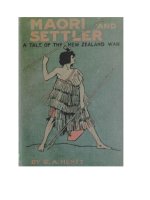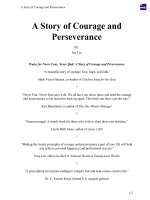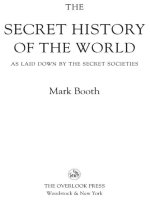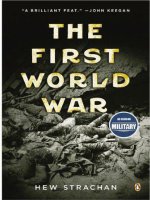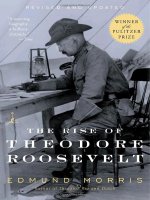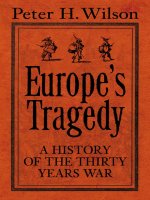Nathaniel philbrick mayflower a story of courage, war (v5 0)
Bạn đang xem bản rút gọn của tài liệu. Xem và tải ngay bản đầy đủ của tài liệu tại đây (2.56 MB, 331 trang )
May flower
ALSO BY NATHANIEL PHILBRICK
The Passionate Sailor
Away Off Shore: Nantucket Island and Its People, 1602–1890
Abram’s Eyes: The Native American Legacy of Nantucket Island
Second Wind: A Sunfish Sailor’s Odyssey
In the Heart of the Sea: The Tragedy of the Whaleship Essex
Sea of Glory: America’s Voyage of Discovery, the U.S.
Exploring Expedition, 1838–1842
VIKING
Published by the Penguin Group
Penguin Group (USA) Inc., 375 Hudson Street, New York, New York 10014, U.S.A. Penguin Group
(Canada), 90 Eglinton Avenue East, Suite 700, Toronto, Ontario, Canada M4P2Y3 (a division of
Pearson Penguin Canada Inc.) Penguin Books Ltd, 80 Strand, London WC2R 0RL, England Penguin
Ireland, 25 St. Stephen’s Green, Dublin 2, Ireland (a division of Penguin Books Ltd) Penguin Books
Australia Ltd, 250 Camberwell Road, Camberwell, Victoria 3124, Australia (a division of Pearson
Australia Group Pty Ltd) Penguin Books India Pvt Ltd, 11 Community Centre, Panchsheel Park, New
Delhi–110 017, India Penguin Group (NZ), Cnr Airborne and Rosedale Roads, Albany, Auckland
1310, New Zealand (a division of Pearson New Zealand Ltd) Penguin Books (South Africa) (Pty)
Ltd, 24 Sturdee Avenue, Rosebank, Johannesburg 2196, South Africa
Penguin Books, Ltd, Registered Offices: 80 Strand, London WC2R 0RL, England
First published in 2006 by Viking Penguin, a member of Penguin Group (USA) Inc.
Copyright © Nathaniel Philbrick, 2006
Maps copyright © Penguin Group (USA) Inc., 2006
All rights reserved
Maps by Jeffrey L. Ward
Illustration credits appear at the end of this book.
LIBRARY OF CONGRESS CATALOGING IN PUBLICATION DATA
Philbrick, Nathaniel.
Mayflower: a story of courage, community, and war / Nathaniel Philbrick.
p. cm.
Includes bibliographical references and index.
ISBN: 978-1-1012-1883-9
1. Pilgrims (New-Plymouth Colony) 2. Massachusetts—History—
New-Plymouth, 1620–1691. 3. Bradford, William, 1590–1657.
4. Church, Benjamin, 1639–1718. I. Title.
F68.P44 2006
973.2'2—dc22 2005058470
Without limiting the rights under copyright reserved above, no part of this publication may be
reproduced, stored in or introduced into a retrieval system, or transmitted, in any form or by any
means (electronic, mechanical, photocopying, recording or otherwise), without the prior written
permission of both the copyright owner and the above publisher of this book. The scanning,
uploading, and distribution of this book via the Internet or via any other means without the permission
of the publisher is illegal and punishable by law. Please purchase only authorized electronic editions
and do not participate in or encourage electronic piracy of copyrightable materials. Your support of
the author’s rights is appreciated.
To Melissa
Contents
List of Maps
Preface: The Two Voyages
Part I Discovery
ONE
They Knew They Were Pilgrims
TWO
Dangerous Shoals and Roaring Breakers
THREE
Into the Void
Beaten with Their Own Rod
FOUR
The Heart of Winter
FIVE
SIX In a
SEVEN
Dark and Dismal Swamp
Thanksgiving
Part II Accommodation
EIGHT
NINE
The Wall
A Ruffling Course
Part III Community
TEN
One Small Candle
ELEVEN
The Ancient Mother
TWELVE
The Trial
Part IV War
THIRTEEN
FOURTEEN
Kindling the Flame
The God of Armies
FIFTEEN
In a Strange Way
SIXTEEN
The Better Side of the Hedge
EPILOGUE
Conscience
Acknowledgments
Notes
Bibliography
Index
Picture Credits
List of Maps
Tracks of the Speedwell and the Mayflower, July–November 1620
Track of the Mayflower off Cape Cod, November 9–11, 1620
Tracks of the Three Exploring Expeditions, November 15–December 12, 1620
Plymouth Harbor
New England, 1625–1674
Mount Hope Region, June–July 1675
Southern New England and New York during King Philip’s War, 1675–1676
Preface: The Two Voyages
WE ALL WANT TO KNOW how it was in the beginning. From the Big Bang to the Garden
of Eden to the circumstances of our own births, we yearn to travel back to that distant time when
everything was new and full of promise. Perhaps then, we tell ourselves, we can start to make sense
of the convoluted mess we are in today.
But beginnings are rarely as clear-cut as we would like them to be. Take, for example, the event
that most Americans associate with the start of the United States: the voyage of the Mayflower.
We’ve all heard at least some version of the story: how in 1620 the Pilgrims sailed to the New
World in search of religious freedom; how after drawing up the Mayflower Compact, they landed at
Plymouth Rock and befriended the local Wampanoags, who taught them how to plant corn and whose
leader or sachem, Massasoit, helped them celebrate the First Thanksgiving. From this inspiring
inception came the United States.
Like many Americans, I grew up taking this myth of national origins with a grain of salt. In their
wide-brimmed hats and buckled shoes, the Pilgrims were the stuff of holiday parades and bad
Victorian poetry. Nothing could be more removed from the ambiguities of modern-day America, I
thought, than the Pilgrims and the Mayflower.
But, as I have since discovered, the story of the Pilgrims does not end with the First
Thanksgiving. When we look to how the Pilgrims and their children maintained more than fifty years
of peace with the Wampanoags and how that peace suddenly erupted into one of the deadliest wars
ever fought on American soil, the history of Plymouth Colony becomes something altogether new,
rich, troubling, and complex. Instead of the story we already know, it becomes the story we need to
know.
In 1676, fifty-six years after the sailing of the Mayflower, a similarly named but far less famous ship,
the Seaflower, departed from the shores of New England. Like the Mayflower, she carried a human
cargo. But instead of 102 potential colonists, the Seaflower was bound for the Caribbean with 180
Native American slaves.
The governor of Plymouth Colony, Josiah Winslow—son of former Mayflower passengers
Edward and Susanna Winslow—had provided the Seaflower ’s captain with the necessary
documentation. In a certificate bearing his official seal, Winslow explained that these Native men,
women, and children had joined in an uprising against the colony and were guilty of “many notorious
and execrable murders, killings, and outrages.” As a consequence, these “heathen malefactors” had
been condemned to perpetual slavery.
The Seaflower was one of several New England vessels bound for the West Indies with Native
slaves. But by 1676, plantation owners in Barbados and Jamaica had little interest in slaves who had
already shown a willingness to revolt. No evidence exists as to what happened to the Indians aboard
the Seaflower, but we do know that the captain of one American slave ship was forced to venture all
the way to Africa before he finally disposed of his cargo. And so, over a half century after the sailing
of the Mayflower, a vessel from New England completed a transatlantic passage of a different sort.
The rebellion referred to by Winslow in the Seaflower ’s certificate is known today as King Philip’s
War. Philip was the son of Massasoit, the Wampanoag leader who greeted the Pilgrims in 1621.
Fifty-four years later, in 1675, Massasoit’s son went to war. The fragile bonds that had held the
Indians and English together in the decades since the sailing of the Mayflower had been irreparably
broken.
King Philip’s War lasted only fourteen months, but it changed the face of New England. After
fifty-five years of peace, the lives of Native and English peoples had become so intimately
intertwined that when fighting broke out, many of the region’s Indians found themselves, in the words
of a contemporary chronicler, “in a kind of maze, not knowing what to do.” Some Indians chose to
support Philip; others joined the colonial forces; still others attempted to stay out of the conflict
altogether. Violence quickly spread until the entire region became a terrifying war zone. A third of the
hundred or so towns in New England were burned and abandoned. There was even a proposal to
build a barricade around the core settlements of Massachusetts and surrender the towns outside the
perimeter to Philip and his allies.
The colonial forces ultimately triumphed, but at a horrifying cost. There were approximately
seventy thousand people in New England at the outbreak of hostilities. By the end of the war,
somewhere in the neighborhood of five thousand were dead, with more than three-quarters of those
losses suffered by the Native Americans. In terms of percentage of population killed, King Philip’s
War was more than twice as bloody as the American Civil War and at least seven times more lethal
than the American Revolution. Not counted in these statistics are the hundreds of Native Americans
who, like the passengers aboard the Seaflower, ended the war as slaves. It had taken fifty-six years to
unfold, but one people’s quest for freedom had resulted in the conquest and enslavement of another.
It was Philip who led me to the Pilgrims. I was researching the history of my adopted home,
Nantucket Island, when I encountered a reference to the Wampanoag leader in the town’s records. In
attempting to answer the question of why Philip, whose headquarters was in modern Bristol, Rhode
Island, had traveled more than sixty-five miles across the water to Nantucket, I realized that I must
begin with Philip’s father, Massasoit, and the Pilgrims.
My initial impression of the period was bounded by two conflicting preconceptions: the timehonored tradition of how the Pilgrims came to symbolize all that is good about America and the now
equally familiar modern tale of how the evil Europeans annihilated the innocent Native Americans. I
soon learned that the real-life Indians and English of the seventeenth century were too smart, too
generous, too greedy, too brave—in short, too human—to behave so predictably.
Without Massasoit’s help, the Pilgrims would never have survived the first year, and they
remained steadfast supporters of the sachem to the very end. For his part, Massasoit realized almost
from the start that his own fortunes were linked to those of the English. In this respect, there is a
surprising amount of truth in the tired, threadbare story of the First Thanksgiving.
But the Indians and English of Plymouth Colony did not live in a static idyll of mutual support.
Instead, it was fifty-five years of struggle and compromise—a dynamic, often harrowing process of
give and take. As long as both sides recognized that they needed each other, there was peace. The
next generation, however, came to see things differently.
When Philip’s warriors attacked in June of 1675, it was not because relentless and faceless
forces had given the Indians no other choice. Those forces had existed from the very beginning. War
came to New England because two leaders—Philip and his English counterpart, Josiah Winslow—
allowed it to happen. For Indians and English alike, there was nothing inevitable about King Philip’s
War, and the outbreak of fighting caught almost everyone by surprise.
When violence and fear grip a society, there is an almost overpowering temptation to demonize
the enemy. Given the unprecedented level of suffering and death during King Philip’s War, the
temptations were especially great, and it is not surprising that both Indians and English began to view
their former neighbors as subhuman and evil. What is surprising is that even in the midst of one of the
deadliest wars in American history, there were Englishmen who believed the Indians were not
inherently malevolent and there were Indians who believed the same about the English. They were the
ones whose rambunctious and intrinsically rebellious faith in humanity finally brought the war to an
end, and they are the heroes of this story.
It would be left to subsequent generations of New Englanders to concoct the nostalgic and reassuring
legends that have become the staple of annual Thanksgiving Day celebrations. As we shall see, the
Pilgrims had more important things to worry about than who was the first to set foot on Plymouth
Rock.
It is true that most of what we know about seventeenth-century New England comes from the
English. In recent decades, however, archaeologists, anthropologists, and folklorists have
significantly increased our understanding of the Native American culture of the time. This does not
alter the fact that any account of the period must depend, for the most part, on contemporary
narratives, histories, letters, documents, and poems written by English men and women.
I have focused on two people, one familiar, the other less so: Plymouth governor William
Bradford and Benjamin Church, a carpenter turned Indian fighter whose maternal grandfather had
sailed on the Mayflower. Bradford and Church could not have been more different—one was pious
and stalwart, the other was audacious and proud—but both wrote revealingly about their lives in the
New World. Together, they tell a fifty-six-year intergenerational saga of discovery, accommodation,
community, and war—a pattern that was repeated time and time again as the United States worked its
way west and, ultimately, out into the world.
It is a story that is at once fundamental and obscure, and it begins with a ship on a wide and
blustery sea.
PART I
Discovery
CHAPTER ONE
They Knew They Were Pilgrims
FOR SIXTY-FIVE DAYS, the Mayflower had blundered her way through storms and
headwinds, her bottom a shaggy pelt of seaweed and barnacles, her leaky decks spewing salt water
onto her passengers’ devoted heads. There were 102 of them—104 if you counted the two dogs: a
spaniel and a giant, slobbery mastiff. Most of their provisions and equipment were beneath them in
the hold, the primary storage area of the vessel. The passengers were in the between, or ’tween,
decks—a dank, airless space about seventy-five feet long and not even five feet high that separated
the hold from the upper deck. The ’tween decks was more of a crawlspace than a place to live, made
even more claustrophobic by the passengers’ attempts to provide themselves with some privacy. A
series of thin-walled cabins had been built, creating a crowded warren of rooms that overflowed
with people and their possessions: chests of clothing, casks of food, chairs, pillows, rugs, and
omnipresent chamber pots. There was even a boat—cut into pieces for later assembly—doing
temporary duty as a bed.
They were nearly ten weeks into a voyage that was supposed to have been completed during the
balmy days of summer. But they had started late, and it was now November, and winter was coming
on. They had long since run out of firewood, and they were reaching the slimy bottoms of their water
casks. Of even greater concern, they were down to their last casks of beer. Due to the notoriously bad
quality of the drinking water in seventeenth-century England, beer was considered essential to a
healthy diet. And sure enough, with the rationing of their beer came the unmistakable signs of scurvy:
bleeding gums, loosening teeth, and foul-smelling breath. So far only two had died—a sailor and a
young servant—but if they didn’t reach land soon many more would follow.
They had set sail with three pregnant mothers: Elizabeth Hopkins, Susanna White, and Mary
Allerton. Elizabeth had given birth to a son, appropriately named Oceanus, and Susanna and Mary
were both well along in their pregnancies.
It had been a miserable passage. In midocean, a fierce wave had exploded against the old ship’s
topsides, straining a structural timber until it had cracked like a chicken bone. The Mayflower ’s
master, Christopher Jones, had considered turning back to England. But Jones had to give his
passengers their due. They knew next to nothing about the sea or the savage coast for which they were
bound, but their resolve was unshakable. Despite all they had so far suffered—agonizing delays,
seasickness, cold, and the scorn and ridicule of the sailors—they had done everything in their power
to help the carpenter repair the fractured beam. They had brought a screw jack—a mechanical device
used to lift heavy objects—to assist them in constructing houses in the New World. With the help of
the screw jack, they lifted the beam into place, and once the carpenter had hammered in a post for
support, the Mayflower was sound enough to continue on.
They were a most unusual group of colonists. Instead of noblemen, craftsmen, and servants—the
types of people who had founded Jamestown in Virginia—these were, for the most part, families—
men, women, and children who were willing to endure almost anything if it meant they could worship
as they pleased. The motivating force behind the voyage had come from a congregation of
approximately four hundred English Puritans living in Leiden, Holland. Like all Puritans, these
English exiles believed that the Church of England must be purged of its many excesses and abuses.
But these were Puritans with a vengeance. Instead of working for change within the established
church, they had resolved to draw away from the Church of England—an illegal act in Jacobean
England. Known as Separatists, they represented the radical fringe of the Puritan movement. In 1608,
they had decided to do as several groups of English Separatists had done before them: emigrate to the
more religiously tolerant country of Holland.
They had eventually settled in Leiden, a university town that could not have been more different
from the rolling, sheep-dotted fields of their native England. Leiden was a redbrick labyrinth of
building-packed streets and carefully engineered canals, a city overrun with refugees from all across
Europe. Under the leadership of their charismatic minister, John Robinson, their congregation had
more than tripled in size. But once again, it had become time for them to leave.
As foreigners in Holland, many of them had been forced to work menial, backbreaking jobs in
the cloth industry, and their health had suffered. Despite the country’s reputation for religious
tolerance, a new and troubling era had come to Holland as a debate among the leading theologians of
the day sparked civil unrest and, on occasion, violence. Just the year before, a member of their
congregation had almost been killed by a rock-hurling crowd. Even worse, a Dutch treaty with Spain
was about to expire, and it was feared Leiden might soon be subjected to the same kind of siege that
had resulted in the deaths of half the city’s residents during the previous century.
But their chief worry involved their children. Gradually and inevitably, they were becoming
Dutch. The congregation had rejected the Church of England, but the vast majority of its members
were still proudly, even defiantly, English. By sailing to the New World, they hoped to re-create the
English village life they so dearly missed while remaining beyond the meddlesome reach of King
James and his bishops.
It was a stunningly audacious proposition. With the exception of Jamestown, all other attempts to
establish a permanent English settlement on the North American continent had so far failed. And
Jamestown, founded in 1607, could hardly be counted a success. During the first year, 70 of 108
settlers had died. The following winter came the “starving time,” when 440 of 500 settlers were
buried in just six months. As it turned out, the most lethal days in Jamestown were yet to come.
Between 1619 and 1622, the Virginia Company would send close to 3,600 settlers to the colony; over
that three-year period, 3,000 would die.
In addition to starvation and disease, there was the threat of Indian attack. At the university
library in Leiden were sensational accounts left by earlier explorers and settlers, telling how the
Indians “delight to torment men in the most bloody manner that may be; flaying some alive with the
shells of fishes, cutting off the members and joints of others by piecemeal and broiling on the coals.”
How could parents willingly subject their children to the risk of such a fate?
In the end, all arguments for and against emigrating to America ended with the conviction that
God wanted them to go. The world, they believed, was on the verge of the millennium—the thousandyear rule of the saints predicted in the book of Revelation. In 1618, a comet appeared in the skies
over Europe, signaling, many thought, the final, apocalyptic battle of good against evil. And, in fact,
what became known as the Thirty Years’ War would rage across the Continent as Protestant and
Catholic forces reduced much of Europe to a burning, corpse-strewn battleground. So far, England
had avoided this conflict, and as all God-fearing English Puritans knew, their country had been
earmarked by the Lord to lead his forces in triumph. Instead of Europe, perhaps America, a continent
previously dominated by the Catholic powers of Spain and France, was where God intended to bring
the reformed Protestant Church to perfection. All Englishmen had heard of the atrocities the
Spaniards’ hateful hunt for gold had inflicted on the Indians of America. England, it had been
predicted by Richard Hakluyt, the chronicler of British exploration, would do it differently. It was the
Leideners’ patriotic and spiritual duty to plant a godly English plantation in the New World. “We
verily believe and trust the Lord is with us,” they wrote, “and that He will graciously prosper our
endeavors according to the simplicity of our hearts therein.”
Their time in Leiden, they now realized, had been a mere rehearsal for the real adventure. “We
are well weaned from the delicate milk of our mother country,” they wrote, “and inured to the
difficulties of a strange and hard land, which yet in a great part we have by patience overcome.” Most
important, however, they were “knit together as a body in a most strict and sacred bond.”
They were weavers, wool carders, tailors, shoemakers, and printers, with almost no relevant
experience when it came to carving a settlement out of the American wilderness. And yet, because of
the extraordinary spiritual connection they had developed as exiles in Leiden and even before, they
were prepared for whatever lay ahead. “[I]t is not with us as with other men,” they confidently
insisted, “whom small things can discourage, or small discontentments cause to wish themselves
home again.” Or, as one of their number, a thirty-year-old corduroy worker named William Bradford,
later wrote, “they knew they were pilgrims.”
Taking Bradford’s lead, we refer to them today as the Pilgrims, a name that is as good as any to
describe a people who were almost always on the move—even after they had supposedly found a
home in America. If not for Bradford’s steady, often forceful leadership, it is doubtful whether there
ever would have been a colony. Without his Of Plymouth Plantation, certainly the greatest book
written in seventeenth-century America, there would be almost no information about the voyage with
which it all began. For William Bradford, however, the true voyage had begun close to twenty years
before.
Bradford was born in the tiny farming town of Austerfield, Yorkshire, deep in northern England,
where the closest thing to a wilderness was the famed Sherwood Forest to the south. The Great North
Road from London to Edinburgh (actually more of a ribbon of mud than a proper road) passed nearby,
but few from Austerfield had ever ventured far from home.
Although he came from a family of prosperous, land-rooted farmers, Bradford had experienced
more than his share of dislocation and loss. By the time he turned twelve, he had lost not only his
father, his mother, and a sister, but also the grandfather who had raised him. Soon after moving in
with his two uncles, he was struck by a mysterious ailment that prevented him from working in the
fields. Bradford later claimed that his “long sickness” had saved him from “the vanities of youth, and
made him the fitter for what he was afterwards to undergo.” Most important, his illness gave him the
opportunity to read.
Lonely and intelligent, he looked to the Bible for consolation and guidance. For a boy in need of
instruction, the Geneva Bible, translated in the previous century by a small team of English ministers
and equipped with helpful notes and appendices, was just the thing. There was also John Foxe’s Book
of Martyrs, a compelling, tremendously popular account of the Protestants martyred by Queen
Elizabeth’s Catholic predecessor on the throne, “Bloody Mary.” Foxe’s insistence that England was,
like Israel before it, God’s chosen nation had a deep and lasting influence on Bradford, and as Foxe
made horrifyingly clear, to be a godly Englishman sometimes required a person to make the ultimate
sacrifice.
At issue at the turn of the seventeenth century—and long before—was the proper way for a
Christian to gain access to the will of God. Catholics and more conservative Protestants believed that
the traditions of the church contained valid, time-honored additions to what was found in the Bible.
Given man’s fallen condition, no individual could presume to question the ancient, ceremonial truths
of the established church.
But for the Puritans, man’s fallen nature was precisely the point. All one had to do was witness a
typical Sunday service in England—in which parishioners stared dumbly at a minister mumbling
incomprehensible phrases from the Book of Common Prayer—to recognize how far most people were
from a true engagement with the word of God.
A Puritan believed it was necessary to venture back to the absolute beginning of Christianity,
before the church had been corrupted by centuries of laxity and abuse, to locate divine truth. In lieu of
time travel, there was the Bible, with the New Testament providing the only reliable account of
Christ’s time on earth while the Old Testament contained a rich storehouse of still vital truths. If
something was not in the scriptures, it was a man-made distortion of what God intended. At once
radical and deeply conservative, the Puritans had chosen to spurn thousands of years of accumulated
tradition in favor of a text that gave them a direct and personal connection to God.
A Puritan had no use for the Church of England’s Book of Common Prayer, since it tampered
with the original meaning of the Bible and inhibited the spontaneity that they felt was essential to
attaining a true and honest glimpse of the divine. Hymns were also judged to be a corruption of God’s
word—instead, a Puritan read directly from the Bible and sang scrupulously translated psalms whose
meaning took precedence over the demands of rhyme and meter. As staunch “primitivists,” Puritans
refused to kneel while taking communion, since there was no evidence that the apostles had done so
during the Last Supper. There was also no biblical precedent for making the sign of the cross when
uttering Christ’s name. Even more important, there was no precedent for the system of bishops that
ran the Church of England. The only biblically sanctioned organizational unit was the individual
congregation.
The Puritans believed that a congregation began with a covenant (a term they took from the
Bible) between a group of believers and God. As a self-created and independent entity, the
congregation elected a university-trained minister and, if the occasion should arise, voted him out.
The Puritans also used the concept of a covenant to describe the individual’s relationship with God.
Ever since the Fall, when Adam had broken his covenant of works with God, man had been deserving
of perpetual damnation. God had since made a covenant with Christ; upon the fulfillment of that
covenant, God had offered a covenant of grace to just a small minority of people, known as the Saints.
The Puritans believed that the identity of the Saints had long since been determined by God. This
meant that there was nothing a person could do to win salvation. But instead of being a reason to
forsake all hope, what was known as predestination became a powerful goad to action. No one could
be entirely sure as to who was one of the elect, and yet, if a person was saved, he or she naturally
lived a godly life. As a result, the Puritans were constantly comparing their own actions to those of
others, since their conduct might indicate whether or not they were saved. Underlying this compulsive
quest for reassurance was a person’s conscience, which one divine described as “the voice of God in
man.”
A Puritan was taught to recognize the stages by which he or she might experience a sureness of
redemption. It began with a powerful response to the “preaching of the word,” in which God revealed
the heights to which a person must aspire if he or she was to achieve grace. This was followed by a
profound sense of inadequacy and despair that eventually served as a prelude to, if a person was
destined to be redeemed, “saving grace.” From this rigorous program of divine discipline a Puritan
developed the confidence that he or she was, in fact, one of the elect. For William Bradford, who had
lost almost everyone he had ever loved, this emotionally charged quest for divinity would lead not
only to the assurance of his own redemption but to the family he had never known.
Bradford was just twelve years old when he became uneasy with the way God was worshipped in
Austerfield. Like just about every village in England, Austerfield possessed a small stone church built
soon after the Norman Conquest in the eleventh century. But the Austerfield church, known as St.
Helena’s, was—and is—unusual. Over the door is a primitive stone carving from a much earlier era
depicting an open-mouthed snake. One can only wonder whether this weird, almost runic figure first
suggested to the young Bradford that the Puritans were right: the Church of England had been
poisoned by “that old serpent Satan.” He must seek out a congregation of like-minded believers and
worship God as the Bible instructed.
In Scrooby, an even tinier town than Austerfield a few miles down the road in northern
Nottinghamshire, he eventually found what he was looking for. In an old manor house, just a few
decades from being demolished, lived the town’s postmaster, William Brewster. It was here that a
group of Separatists gathered every Sunday to worship in secret under the direction of two ministers,
one of whom was the young John Robinson.
Taking their cue from Paul’s admonition “come out among them, and be separate,” the
Separatists were Puritans who had determined that the Church of England was not a true church of
Christ. If they were to remain true to their faith, they must form a church of what were known as
visible Saints: members of the elect who upheld each other in the proper worship of God. If members
of the congregation strayed from the true path, they were admonished; if they failed to correct
themselves, they were excommunicated. Purged of the ungodly, a Separatist congregation shared in an
intense fellowship of righteousness that touched every facet of every communicant’s life.
St. Helena’s Church in Austerfield, Yorkshire
The Separatists believed in spiritual discipline, but they also believed in spontaneity. After the
minister concluded his sermon, members of the congregation were encouraged to “prophesy.” Instead
of looking into the future, prophesying involved an inspired kind of improvisation: an extemporaneous
attempt by the more knowledgeable members of the congregation to speak—sometimes briefly,
sometimes at great length—about religious doctrine. By the end of the service, which lasted for
several hours, the entire congregation had participated in a passionate search for divine truth.
Adding to the intensity of the spiritual bond shared by the Separatists in Scrooby was the fact
that they were engaged in an illegal activity. During the previous century, several Separatists had
been jailed and even executed for their beliefs, and since the coronation of King James in 1603, the
pressure to conform to the Church of England had been mounting. From James’s perspective, all
Puritans were troublemakers who threatened the spiritual integrity of his realm, and at a gathering of
religious leaders at his palace in Hampton Court, he angrily declared, “I shall harry them out of the
land!” In the years since the Hampton Court Conference, increasing numbers of men and women had
been prosecuted for their unorthodox religious beliefs. As Separatists, the congregation at Scrooby
was in violation of both ecclesiastical and civil law, and all of them undoubtedly knew that it was
only a matter of time before the authorities found them out.
Some time in 1607, the bishop of York became aware of the meetings at Brewster’s manor
house. Some members of the congregation were thrown in prison; others discovered that their houses
were being watched. It was time to leave Scrooby. But if King James had vowed to “harry” the
Puritans out of England, he was unwilling to provide them with a legal means of leaving the country.
A person needed official permission to voyage to the Continent, something the authorities refused to
grant religious nonconformists such as the Separatists from Scrooby. If they were to sail for Holland,
they must do it secretly.
For a group of farmers and artisans most of whom had rarely, if ever, ventured beyond the
Nottinghamshire-Yorkshire region, it was a most daunting prospect. But for seventeen-year-old
Bradford, who would lose the people upon whom he had come to depend if he did not follow them to
Holland, there was little choice in the matter. Despite the vehement protests of his friends and
relatives, who must have pointed out that he was due to receive a comfortable inheritance at twentyone, he decided to sail with John Robinson and William Brewster to a new land.
Their escape from England did not go well. The first captain they hired turned out to be a traitor and a
thief who surrendered them to the authorities in the Lincolnshire town of Boston. After their leaders
had spent several months in jail, they tried again. This time they secured the services of a trustworthy
Dutch captain, who planned to meet them on the southern bank of the Humber River, just above the
town of Grimsby. But they’d loaded no women and children and only a portion of the men onto the
ship when the local militia appeared. Fearing capture, the captain determined to sail for Amsterdam,
leaving the women and children weeping in despair as their husbands looked on from the deck of the
departing ship. It was several months before they were all reunited in Holland.
Once in Amsterdam, the Separatists from Scrooby found themselves thrust into conflict and
contention. As dissidents who had come to define themselves in opposition to an established
authority, Separatists were often unprepared for the reality of being able to worship as they wanted in
Holland. Relieved of all doctrinal restraint, the ministers of several English Separatist congregations
began to advocate positions that put them at odds with their own flocks. The minister of an English
congregation from Gainsborough (only a few miles from Scrooby) had decided to reject infant
baptism; another minister attempted to quell a messy series of personal scandals by claiming that he
and his elders, or church officers, could dictate policy to their congregation. As fellow English
Separatists, it was impossible for the newcomers from Scrooby to avoid becoming embroiled in these
quarrels if they remained in Amsterdam. Showing the firmness, sensitivity, and judgment that came to
characterize his ministry in the years ahead, John Robinson led the majority of the congregation to the
neighboring city of Leiden, where they were free to establish themselves on their own terms.
Leiden, Holland, in the early seventeenth century
In Leiden, Robinson secured a house not far from the Pieterskerk, one of the city’s largest
churches. In the garden behind Robinson’s home, they created a miniature village of close to a dozen
houses. Even though approximately half the congregation lived in houses elsewhere in the city, what
was known as De Groene Poort, meaning the green lane or alley, came to represent the ideal of
Christian fellowship they would aspire to for the rest of their lives.
William Bradford soon emerged as one of the leading members of the congregation. When he
turned twenty-one in 1611, he sold the property he had inherited in Austerfield and used the proceeds
to purchase a small house. A fustian, or corduroy worker, Bradford became a citizen of Leiden in
1612 in recognition of his high standing in the community. In 1613, he married Dorothy May, and four
years later they had a son, John. But Bradford’s life in Leiden was not without its setbacks. At one
point, some poor business decisions resulted in the loss of a significant portion of his inheritance. In
typical Puritan fashion, he interpreted this as a “correction bestowed by God…for certain decays of
internal piety.”
From the beginning, the Pilgrims exhibited all the strengths and weaknesses of a group held
together by “a most strict and sacred bond.” When circumstances turned against them, they
demonstrated remarkable courage and resilience; indeed, adversity seemed to intensify their clannish
commitment to one another. Once established in Leiden, they acquired a renewed sense of purpose—
despite, or because of, the hardships of exile.
Leiden was a thriving city of forty thousand, but it was also a commercial center that required its
inhabitants to work at a pace that must have come as a shock to farmers from Nottinghamshire and
Yorkshire. A life of husbandry involved periods of intense labor, but its seasonal rhythms left long
stretches of relative inactivity. In Leiden, on the other hand, men, women, and even children were
expected to work from dawn to dusk, six days a week, with a bell sounding in the tower of the yarn
market to announce when work was to begin and end. As the years of ceaseless labor began to mount
and their children began to lose touch with their English ancestry, the Pilgrims decided it was time to
start over again.
The members of Robinson’s congregation knew each other wonderfully well, but when it came
to the outside world they could sometimes run into trouble. They were too focused on their own inner
lives to appreciate the subtleties of character that might have alerted them to the true motives of those
who did not share in their beliefs. Time and time again during their preparations to sail for America,
the Pilgrims demonstrated an extraordinary talent for getting duped.
It began badly when William Brewster ran afoul of the English government. In Leiden, he had
established a printing press, which he ran with the help of the twenty-three-year-old Edward
Winslow. In 1618 Brewster and Winslow published a religious tract critical of the English king and
his bishops. James ordered Brewster’s arrest, and when the king’s agents in Holland came to seize
the Pilgrim elder, Brewster was forced into hiding just as preparations to depart for America entered
the most critical phase.
Brewster was the only Pilgrim with political and diplomatic experience. As a young man, he had
served as an assistant to Queen Elizabeth’s secretary of state, William Davison. Brewster’s budding
diplomatic career had been cut short when the queen had used Davison as her scapegoat for the
execution of Mary Queen of Scots. With his mentor in prison, Brewster had been forced to return
home to Scrooby, where he had taken over his father’s position as postmaster.
In addition to having once been familiar with the highest levels of political power, Brewster
possessed an unusually empathetic nature. “He was tenderhearted and compassionate of such as were
in misery,” Bradford wrote, “but especially of such as had been of good estate and rank and were
fallen unto want and poverty.” More than anyone else, with the possible exception of Pastor
Robinson, Elder Brewster was the person upon whom the congregation depended for guidance and
support. But as they wrestled with the myriad details of planning a voyage to America, Brewster was,
at least for now, lost to them.
By the beginning of the seventeenth century, it had become apparent that the colonization of North
America was essential to England’s future prosperity. France, Holland, and especially Spain had
already taken advantage of the seemingly limitless resources of the New World. But the British
government lacked the financial wherewithal to fund a broad-based colonization effort of its own.
Seeing it as an opportunity to add to their already considerable personal wealth, two groups of
noblemen—one based in London, the other to the west in Plymouth—were eager to underwrite British
settlements in America, and in 1606, James created the Virginia Company. But after the Plymouth
group’s attempts to found a colony in modern Maine failed miserably and Jamestown proved to be
something less than a financial success, the two branches of the Virginia Company realized that they,
too, lacked the resources required to colonize America. They then resolved to franchise future
settlements by issuing subsidiary, or “particular,” patents to those interested in beginning a plantation.
These conditional patents gave the settlers the right to attempt to found a colony in five to seven
years’ time, after which they could apply for a new patent that gave them permanent title to the land.
With Brewster in hiding, the Pilgrims looked to their deacon John Carver, probably in his
midthirties, and Robert Cushman, forty-one, to carry on negotiations with the appropriate officials in
London. By June 1619, Carver and Cushman had succeeded in securing a patent from the Virginia
Company. But the Pilgrims’ plans were still far from complete. They had a patent but had not, as of
yet, figured out how they were going to finance the endeavor. But William Bradford’s faith in the
undertaking was so strong that he sold his house in the spring of 1619.
Soon after, disturbing news came from London. Robert Cushman reported that a group very
similar to their own had recently met with disaster on a voyage to America. Led by a Mr. Blackwell,
180 English Separatists from Emden, Holland, had sailed that winter for Virginia. By the time the
ship reached America, 130 of the emigrants, including Blackwell, were dead. “[T]hey were packed
together like herrings,” Cushman wrote. “They had amongst them the flux, and also want of fresh
water, so as it is here rather wondered at that so many are alive, than so many are dead.” Still, the
news was deeply troubling to those in Leiden, and many of them began to have second thoughts about
sailing to America. Even Cushman had to admit that he, a grocer and wool-comber originally from
Canterbury, felt overwhelmed by the challenges and responsibilities of organizing the voyage. “It doth
often trouble me,” he wrote, “to think that in this business we are all to learn and none to teach.”
About this time some representatives from Holland, having heard of the Pilgrims’ intention to
relocate to America, “made them fair offers” concerning a possible settlement. But the Pilgrims
declined. It would have been impossible to reassert their English identity in a Dutch colony. What
they do not seem to have taken into account was the possible danger of spurning this particular
overture. The Dutch, still several years from founding a colony at Manhattan, appear to have begun to
work covertly to block the Pilgrims’ subsequent attempts to settle in this strategic location.
Instead of looking to Holland, the Pilgrims threw in their lot with a smooth-talking merchant
from London named Thomas Weston. Weston represented a group of investors known as the Merchant
Adventurers—about seventy London merchants who viewed the colonization of America as both an
investment opportunity and a way “to plant religion.” Most of them appear to have shared Puritan
spiritual leanings, although some were clearly wary of the radicalism of the Pilgrims’ Separatist
beliefs. Even though the Pilgrims had secured a patent the year before, the Merchant Adventurers
obtained a patent of their own for a settlement in the northern portion of Virginia at the mouth of the
Hudson River.
In the beginning, Weston seemed a godsend—a man sympathetic to their religious goals who
also claimed to have the means to make their cherished dreams a reality. Weston proposed that they
enter into a joint stock company. The Adventurers would put up most of the capital with the
expectation that, once they were settled in America, the Pilgrims would quickly begin to generate
considerable profits, primarily through codfishing and the fur trade. The Pilgrims would each be
given a share in the company valued at ten pounds. For the next seven years they would work four
days a week for the company and two days a week for themselves, with the Sabbath reserved for
worship. At the end of the seven years, the capital and profits would be divided among all of them,
with the Pilgrims owning their houses and home lots free and clear.
As the spring of 1620 approached, many had decided to wait until those in the “first brunt” had
cleared the way for them; still others, such as Bradford, had already sold their homes and had long
since been ready to depart. A census of the congregation revealed that only about 125 people (a third
of their total number) would be departing for the New World, with the rest to follow soon after.
Pastor Robinson, it was decided, would stay for now in Leiden with the majority of his flock, with
Elder Brewster attending to the religious needs of those in America.
As the Pilgrims prepared to depart in the spring of 1620, Weston’s true nature began to reveal
itself. He now claimed that circumstances had changed, making it necessary to adjust the original
agreement. He had hoped to secure a fishing monopoly for the settlement, but it was now clear that
this was not possible. Many of his fellow Adventurers, he maintained, were inclined to back out. If
the merchants in London were to come forward with the necessary funds, the Pilgrims must agree to
dedicate all their time to working for the company. Instead of having two days a week for themselves,
they must spend every minute laboring for the Adventurers. Robinson and the Pilgrims in Leiden
vehemently objected, claiming that the new terms were “fitter for thieves and bondslaves than honest
men.” Making matters all the worse was that Robert Cushman had agreed to Weston’s new terms
without consulting the rest of them back in Leiden.
In June they discovered that, incredibly, Weston had not yet arranged any transportation to
America. If they had any hope of reaching the mouth of the Hudson River before winter, they must
depart as soon as possible. While Weston hunted up a ship in London, the Pilgrims decided to
purchase a small sailing vessel of their own in Holland. Not only would it be used to transport some
of them across the Atlantic, it would be useful for both fishing and exploring the coast once they were
in America. And if the worst should happen, it would provide a means for the survivors to return to
England.
Adding to the Pilgrims’ growing sense of alarm was the fact that the Adventurers had insisted on
adding some non-Separatists from London to the mix. Some had strong ties to the group in Leiden, but
others were completely unknown to them. How they would get along with these “Strangers” was of
deep concern, especially since one of them, a man named Christopher Martin, was already proving to
be a most difficult personality. The Adventurers designated Martin as a purchasing agent, and he,
along with Cushman and Carver, began to secure supplies and provisions: beer, wine, hardtack,
salted beef and pork, dried peas, fishing supplies, muskets, armor, clothing, tools, trade goods for the
Indians, and the screw jack that would come in handy even before they reached America.
Departure of the Pilgrims from Delfshaven by Adam Willaerts, 1620
Martin, a haughty and willful man, refused to coordinate his efforts with Carver and Cushman.
While the Pilgrim agents collected provisions in London and Canterbury, Martin proceeded to do as
he pleased in Southampton, a major port in the south of England. Soon, no one really knew where
matters stood when it came to provisions. “[W]e are readier to dispute than to set forward a voyage,”
Cushman lamented on June 10.
Despite the chaotic and acrimonious nature of the preparations in England, the Pilgrims in
Leiden forged ahead, purchasing a sixty-ton vessel named the Speedwell. Less than fifty feet in length,
she was considered large enough for a voyage across the Atlantic; earlier expeditions had
successfully completed the crossing in vessels that were less than half the Speedwell’s tonnage. The
Pilgrims hired a master and crew who agreed to stay on for at least a year in America and who
undoubtedly oversaw the fitting out of the vessel with two new and larger masts. The refitting of the
Speedwell may have seemed like an insignificant matter at the time. As it turned out, however, this
misnamed vessel and her master, known to us only as “Mr. Reynolds,” would have a disastrous
impact on the voyage ahead.
By the end of July, the Pilgrims, accompanied by a large number of family and friends, had made
their way to Delfshaven, the small Dutch port where the Speedwell was waiting. The plan was to sail
for Southampton, where they would rendezvous with whatever ship Weston had secured in London.
“[T]hey went aboard and their friends with them,” Bradford wrote, “where truly doleful was the sight
of that sad and mournful parting, to see what sighs and sobs and prayers did sound amongst them,
what tears did gush from every eye, and pithy speeches pierced each heart.”
For Bradford and his wife, Dorothy, the parting in Delfshaven was particularly painful. They
had decided to leave their three-year-old son, John, behind in Holland, perhaps with Dorothy’s
parents in Amsterdam. It was certainly safer for the child, but the emotional cost, especially for the
boy’s mother, would become increasingly difficult to bear. Whether he realized it or not, Bradford
was inflicting his own childhood experience on his son: for a time, at least, John would be, for all
intents and purposes, an orphan.
When the tide turned in their favor, it was time to depart. Pastor Robinson fell down to his knees
on the Speedwell ’s deck, as did everyone present, and “with watery cheeks commended them with
most fervent prayers to the Lord and His blessing.” It was a remarkable display of “such love as
indeed is seldom found on earth.” Years later, the residents of Delfshaven were still talking about the
departure of the Pilgrims in July 1620.
By the time the Leideners departed from Delfshaven, Weston had hired an old and reliable ship
named the Mayflower, which after taking aboard passengers in London sailed to Southampton to
rendezvous with the Speedwell. Southampton was an ancient English port encircled by a medieval
stone wall, and near the West Gate of Southampton, the Leiden contingent got their first glimpse of the
ship that was to sail with them to America.
The Mayflower was a typical merchant vessel of her day: squarerigged and beak bowed, with
high, castlelike superstructures fore and aft that protected her cargo and crew in the worst weather,
but made beating against the wind a painfully inefficient endeavor. Rated at 180 tons (meaning that
her hold was capable of accommodating 180 casks or tuns of wine), she was approximately three
